Petteia XXI

Diagram 1 - Petteia
Petteia (Poleis, Cities or the Game of Pebbles) was an ancient attrition warfare game played in Ancient Greece.

The Greek territories during the Archaic period (c. 8th century BC), and a vase depicting Ajax and Achilles playing Petteia during the Trojan War.

Diagram 1b - Sample Petteia XXI attrition attack position: Jose Carrillo (CAN) - Per Hommerberg, after 25.d6-h6xh5 1-0
White's attrition attack has isolated the Black-eastern forces. Any attempt by Black to save those soldiers will continue to wear down the Black-army. White's attrition warfare has brought Black to the point of collapse through continuous losses in material.
Petteia is played with black and white stones initially lined up on opposite sides of the board. The main attacking tactic is to capture enemy stones by surrounding them between two friendly soldiers.
This colorful description of what is believed to be the Roman game of Latrunculi, also describes (in a beautiful way) what a Greek Petteia struggle feels like:
Cunningly the pieces are disposed on the open board and battles are fought with soldiery of glass, so that now White blocks Black, now Black blocks White. But every foe yields to thee, Piso; marshalled by thee, what piece ever gave way? What piece on the brink of death dealt not death to his enemy? Thousand-fold are thy battle tactics: one man in fleeing from an attack himself overpowers him, another, who has been standing on the look-out, comes up from a distant corner; another stoutly rushes into the mêlée and cheats his foe now creeping on his prey; another courts blockade on either flank and under feint of being blocked, himself blocks two men; another's objective is more ambitious, that he may quickly break through the massed phalanx, swoop into the lines and, razing the enemy's rampart, do havoc in the walled stronghold. Meantime, although the fight rages fiercely, the hostile ranks are split, yet thou thyself are victorious with serried lines unbroken or despoiled maybe of one or two men and both thy hands rattle with the prisoned throng.
The fragment of text above comes from a poem in Latin known as Laus Pisonis which was written by Saleius Bassus during the middle of the 1st century A. D.
Latrunculi (Ludus latrunculorum or the Game of Little Soldiers), the ancient strategy game played throughout the Roman Empire, is believed to be similar or a variant of the Greek game of Petteia.

Diagram 2 - Latrunculi (10x8) and Single Stone Latrunculi (8x8)
Latrunculi and Petteia can be thought of as the Chess and Draughts games of the Roman Empire and of Ancient Greece.
Single Stone Latrunculi is a simpler (training) variation which is played like Latrunculi (but without Duxes) or as Petteia (with only one row of soldiers).
Petteia XXI is one of two ancient abstract strategy games that I reengineered in 2015 to introduce my son Joseph to the world of variants. My other variant, Latrunculi XXI, is played with the same rules as Petteia XXI, except that the former game introduces the concept of Duxes (Kings), which need to be immobilized or checkmated to end the game.
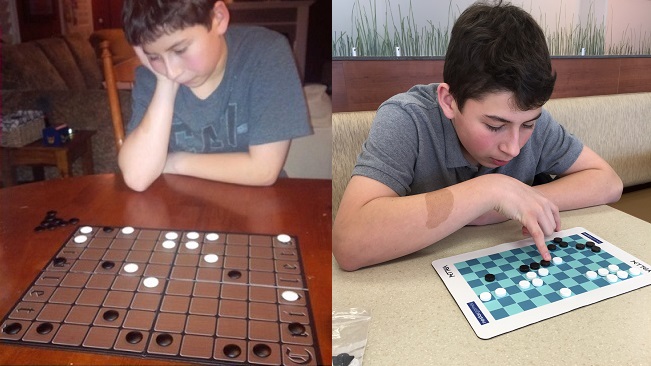
Diagram 3 - My son Joseph and I playing Petteia XXI. On the left by using Japanese Go stones to represent the soldiers, on an 8x10 board for a cards game called Criblets. On the right, we are using an 8x12 Petteia set from nestorgames.
My objective when I created Petteia XXI and Latrunculi XXI was to make a set of rules and tactics for the ancient Greek and Roman games, which would allow a modern 'XXI' (a.k.a. 21st) century player to force a win on his/her opponent, therefore minimizing the number of draws, without relying on any serious mistakes in play by one side or the other.
At first the rules of Petteia XXI may seem long and complicated, but as you will quickly find out, the game is actually quite easy to play.
Learning to move the pieces is the easy part. Mastering the strategy and tactics needed to annihilate his/her opponent, is the real challenge of this variation of the ancient Greek game.
Petteia XXI is not only a good alternative game for Draughts-variant lovers; but also a great training tool for Latrunculi XXI players, to get experience with the moves and tactics of the soldiers or pawns.
Setup
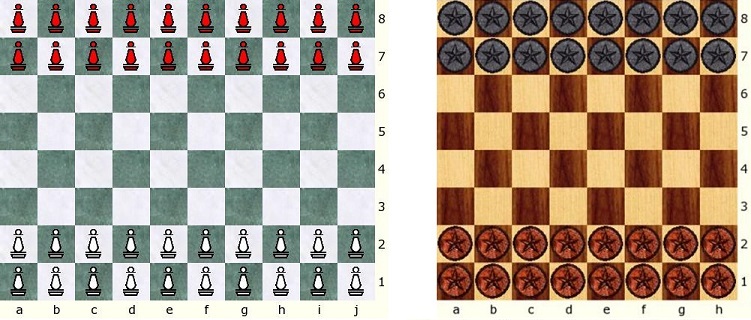
Diagram 4 - A 10x8 and 8x8 Petteia opening setups
Regardless of the size of the board, the Petteia opening setup looks like a 2-row Testudo rectangular formation (see definition 3 later on below) with soldiers in each of the players' first two ranks, as follows:
White (Brown) Soldiers (or Pawns):
a1, b1, c1, d1, e1, f1, g1, h1 (... i1, j1 ...)
a2, b2, c2, d2, e2, f2, g2, h2 (... i2, j2 ...)
Black Soldiers (or Pawns):
a7, b7, c7, d7, e7, f7, g7, h7 (... i7, j7 ...)
a8, b8, c8, d8, e8, f8, g8, h8 (... i8, j8 ...)
A Petteia board itself is called the City, and the edges of the board represent the Walls of the city. The Walls of the City (the edges of the board) take an important role in the development of some of the battles in Petteia XXI.

When you play Petteia, picture yourself battling with your opponent inside a medieval walled city, like the one above. This one is Monteriggioni in the province of Siena in Italy.
Pieces
Soldiers (Pawns) move orthogonally any number of squares, just like Orthodox Chess Rooks. No diagonal moves are allowed. Pieces cannot jump other pieces.However, unlike in Chess or Checkers, captures in Petteia are done by custodial attacks, similar to how it's done in other games like: Hasami Shogi, by the pawns in Robert Abbott's Ultima or Roberto Lavieri's Maxima; a type of capture common to other games like Seega (Egypt) and the Scandinavian family of Tafl games.
A 2nd piece must move in to attack, by surrounding either horizontally or vertically, an enemy soldier (already in attack) to perform a capture.
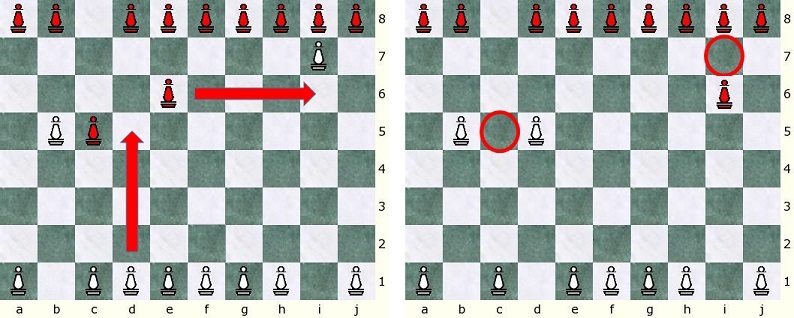
Diagram 5 - Sample custodial captures
After white plays: d1-d5xc5 and black plays: ... e6-i6xi7 (right diagram), the c5 and i7 soldiers are captured and removed from the board.
However it is possible for a piece to move in between two men, without risking an immediate capture (or suicide) of the moving piece. Capturing is only possible in an attacking move.

Diagram 6 - Soldiers moving safely between two enemy pieces: white plays i1-i6, and black ... c8-c4
This time the soldiers at c4 and i6 are perfectly safe. The black soldier at c4 is said to be sandwiched-in, but this time (for the time being) is actually well positioned and has a relative fork on white's b4 and d4 soldiers, as with black's next move a8-a4 or e8-e4 (orange arrows), one of the two white soldiers will fall.
A situation that can occur in Petteia happens when a piece moves in such a way that more than one enemy soldier is captured. Look at the example below:

Diagram 7 - Sample Dual Capture, as a the consequence of a double custodial attack
The soldier at h5 moves to c5 and surrounds both of black's b5 and c4 soldiers (which are both locked in one-to-one skirmishes, and performs two custodial-captures at once. The notation for this move is: h5-c5xb5xc4
Since Petteia uses custodial captures (capture by surrounding) as the principal offensive tactic to capture enemy soldiers, it always takes at least two soldiers to perform a capture.
Rules
Below are the classical rules for Petteia:- The object of the game is to wear down your opponent to the point of collapse by rendering him/her unable to make any moves (i.e. a stalemate), or...
- ... to either reduce to only one piece or completely annihilate the opponent's army.
- All pieces move like Orthodox Chess Rooks.
- Pieces can neither play diagonally nor jump each other (like in checkers or draughts).
- Soldiers are captured by means of the custodial attacks tactic (moving in to surround an enemy soldier between two friendly pieces).
- A piece can move safely in between two enemy pieces, without being captured.
- Multiple soldiers can be captured in one turn. (example: creating multiple custodial capture situations with the same move)
- A soldier in a corner of the board can be captured if surrounded an attacked both vertically and horizontally.
- Captures are not mandatory. (just like in chess)

Diagram 8 - Sample custodial attacks (rule 5) and a corner attack (rule 8)
The example above shows the two soldiers (at d1 and g4) that can move to d4, surround and capture the enemy soldier at c4, who is already locked (i.e. unable to move, see rule 10 below) in a skirmish with the b4 soldier.
A special type of custodial capture is shown at the top corner of the board. The black j8 soldier is already in a one-to-one skirmish with the white i8 soldier. The white j5 soldier can play to j7 to surround the black soldier in the corner against the walls of the city, and to capture him.
In addition to the nine classical rules above, in Petteia XXI there is 50-move draw rule and the Threefold Repetition rule gives a loss for the player forcing the 3rd repetition.
Draws are discouraged in Petteia XXI. However, players can agree to a draw if they believe that the position merits that outcome. If the game goes for 50 moves without a capture, the game is automatically a draw.
The classical Petteia rules provide the basics for the ancient Greek game. However, without a few additional new rules, a game played between two strong players will end up in a draw; as the rules above do not provide enough tactics for players to force a win on his/her opponent, unless one of the players made several serious errors in their play. A game that can at best end in a draw (if well played) would be a boring game.
Since Soldiers move like rooks, special rules exist in Petteia XXI to limit mobility or to allow special captures, otherwise games played with the classical rules could turn into drawish back and forth move affairs, where players try to maintain their soldiers on the diagonals, so as to avoid damaging their position. Look at this example:

Diagram 9 - Sample classical Petteia diagonals-formation
With the reconstructed classical Petteia rules, by keeping their soldiers in the diagonals, players can continue to move back and forth to protect their position, and the game would result in nothing but a lengthy and boring draw.
The following diagram shows the end-game positions for two actual Petteia XXI games played in Game Courier:

Diagram 10 - Positions after 47.f8-b8xb7 1-0 (left, Lerouge vs Carrillo, October 2016) and 33.a7-g7 1-0, stalemate (right, Carrillo vs Lerouge, August 2016)
In the position on the left, Black has only one soldier left and is no longer able to perform any captures, therefore the game is over.
In the position on the right, Black does not have any legal moves, therefore he is stalemated and lost the game. Black's three soldiers are engaged in individual combats (circled in red), and in Petteia XXI they are not allowed to escape or abandon their current combat post (see rule 10 below). The Black pawns are "locked" and unable to move, just like pawns in chess can be "blocked" by enemy pawns.
What follows now is my special set of additional rules that make Petteia XXI into a very playable game that does not depend on anyone making serious errors in play, and yet they give the game the spirit of a battle.
New Petteia XXI Tactics:
-
Impacting Mobility:
- Locked Soldiers (rules 10 and 11)
- Support and Redeployment (rule 12)
New Offensive Attacks:
- Push and Crush attacks (rule 13, a & b)
- Flank attack (rule 14)
- Testudo formation and Phalanx attack (rule 15)
Petteia XXI additional rules and definitions
- Definition #1 - There are two types of moves in Petteia XXI:
- Offensive Moves
- All captures
- Non-Offensive Moves
- Anything else (defensive, escapes, strategic, etc.)

Diagram 11 - Sample offensive moves
All moves above are offensive moves as they all complete a capture. Any other move would be non-offensive.
- Offensive Moves
- Definition #2 - In Petteia XXI, a skirmish is defined as a situation where a piece is orthogonally adjacent to an enemy piece. A group of three or more enemy pieces engaged in more than one skirmish is called a melee.

Diagram 12 - Sample skirmishes and melees
- One-on-one skirmishes: d7-e7 and i8-j8 enemy soldier pairs
- Two-on-one melees: the following trios: a6-a5-b5, a5-b5-b4, f4-f3-f2, i6-i5-j5, i2-i3-j3
- Three-on-one melee: the a1-b2-c1-b1 group
- Melees: all of the groups above, except for the i8-j8 and d7-e7-e6 groups
- Not in a skirmish: e6-soldier (as it is not in orthogonal contact with an enemy piece)
- Rule #10 - Enemy Soldiers in a skirmish are locked (to the square) and cannot make any non-offensive moves. (i.e. they just can't abandon their post to simply relocate somewhere else on the board for a defensive or escape purpose)
- Rule #11 - Locked soldiers can only break the lock to make offensive moves. In other words, a soldier that is engaged in a skirmish can abandon his current combat post, if his move forces a capture somewhere else on the board.
The diagram below displays the two rules above.

Diagram 13 - Soldiers locked in a skirmish, unable to move (rule 10) on left, and the b5-soldier still being able to move to capture (rule 11) on right
In the diagram on the left above, you can see two pairs of enemy soldiers engaged in one-to-one skirmishes. The mere fact that they are adjacent to one (and only one) enemy soldier is what defines the skirmish tactic, which disables both soldiers from moving non-offensively (i.e. to relocate to another square on the board without forcing a capture).
In the diagram above to the right (which is similar to the one on the left), there is a very special distinction. Once again all 4 soldiers are engaged in separate one-to-one skirmishes; but out of the 4 soldiers, the white one at b5 can actually still do an offensive play (his only legal move) by moving to h5 and capturing the black i5 soldier. Other than for this move (b5-h5xi5) neither of the four soldiers in question have any other legal moves.
The two rules above complement each other to eliminate back and forth moves in Petteia XXI (and thus to minimize the number of draws), while at the same time increase the attacking opportunities.
- Rule #12 - A soldier in a melee (many-to-one skirmish) that is supported by other friendly forces, is allowed to be redeployed and can abandon his post as long as all enemy pieces he was in combat with, remain still locked in a skirmish against other friendly piece(s).
The following diagram will help demonstrate rule 12:

Diagram 14 - Soldier redeployment options (yellow and purple arrows)
In the diagram on the left the black soldier at b5 is engaged in a pair of one-to-one skirmishes, therefore it cannot move (rule 10). Likewise, by the same rule (10) the two enemy soldiers at i4 and i5 would not be able to move. However now by means of rule 12, either one of the white soldiers at b4 or c5, is allowed to move in any way the player wishes. The consequence of this rule is that after one of the two white soldiers move, the other white soldier will be left locked in a one-to-one skirmish with the original black c4-soldier.
The diagram on the right is after b4-f4 and i8-i4. White's c5 soldier can no longer legally move, as he is now in a skirmish with the black soldier at b5 without the support from another friendly soldier. Meanwhile the black i5-soldier which could not previously freely move, is now able to move again (rule 12) as he is now supported by the black soldier at j4 in their combat with white's i4 soldier.
The following corollary is not really a rule, but a point of clarification to rule 12.
- Corollary #12i - A soldier in a melee (many-to-one skirmish) CANNOT move unless all the enemy pieces he is in combat with, would still remain locked in a skirmish against other friendly piece(s).
The Black soldier at b5 (left diagram above) and White's i4 soldier (right diagram above) cannot legally move (by corollary 12i).
The soldier mobility rules may be confusing to some who cannot see intuitively which pieces are locked or not. However there are two simple rules of thumb that summarize the soldier mobility rules:
Soldier's Mobility Rules of Thumb:
- Soldiers can always move to capture.
- Soldiers fighting in a combat (skirmish or melee) can only move if (and only if) every one of the enemy soldiers it was in combat with, will remain in some sort of combat after the move.
Now look at the following position:

Diagram 15 - Sample classical Petteia blocked position
This is occurs often in the classical game, as could happen as well as in Petteia XXI (even with the 3 new rules and tactics above).
In order to not to affect their positions, both players could move their free pawns at c7 and g1 almost indefinitely, and with so many squares available to each of the soldiers, it would take a long time before the game ended by means of either the Threefold Repetition or 50-move draw rules.
Positions like the above one inspired a new set of tactics called Linear Attacks. These new attacks allow the captures to be achieved by special maneuvers which can capture enemy soldiers in the same direction of the attack.
The list of Linear Attacks include:
- Pushing and crushing
- Flank attack, which sandwiches multiple enemy soldiers between two soldiers.
- Phalanx attack
Tactic #3 - The Push and Crush
- Rule #13 - A piece can push a single friendly piece and crush an enemy soldier against the Walls of the City or against another friendly piece, to accomplish the capture of the enemy soldier.
Lets split this rule in two two separate parts with examples:
- Rule #13a - A piece can push and crush an enemy soldier against the Walls of the City, to accomplish the latter's capture. To perform this tactic, a piece has to push another (and only ONE) friendly piece to crush the enemy soldier against the Wall. The push has to be in the same direction of the two soldiers locked in combat and the crush has to be perpendicular against an edge of the board.

Diagram 16 - Sample push and crush attack against the wall
Look at the same barricaded position as before (above left) and note the white g4 soldier. According to rule 10, the g4-soldier normally could not move. However rule 13a defines a new offensive capture type, and rule 11 enables the soldier to move offensively to h4 to push his partner at i4 (in the same direction as the enemy soldier to be captured) to crush the black j4-soldier against the Wall. After this move (g4-h4xj4) the black soldier is removed from the board.
- Rule #13b - A piece can push and crush a sandwiched-in enemy soldier, to accomplish the latter's capture. To perform this tactic, a piece has to push another (and only ONE) friendly piece to crush the enemy soldier against a 2nd friendly piece. The push has to be in the same orthogonal direction of the three soldiers engaged in the sandwiched position. The crush is completed when the enemy soldier is pushed onto the weapons of the friendly soldier at his back.

Diagram 17 - Sample push and crush attack against another friendly piece
Lets return to the same barricaded position as before (above left) and this time note the black d5-soldier. According to rule 10, the d5-soldier normally could not move. However rule 13b expands the push and crush tactic, and rule 11 enables the soldier to move offensively from d5 to f5 to push his partner at g5 to crush the black h5-soldier against the friendly weapons of the i5-soldier. After this move (d5-f5xh5) the white soldier is removed from the board.
Look at the position below where two different tactics are combined to perform two captures at once:

Diagram 18 - Black plays g5-c5xa5xc4, a push and crush attack and a custodial capture
- Rule #14 - The enemy soldier in the rear of a linear defensive formation can be captured by means of a charging flank attack. The way this tactic works is simple: a friendly piece launches an attack by charging onto the back (and in the same direction) of a linear enemy formation, sandwiching-in any number of enemy pieces (2, 3 or more) between two friendly troops, thrusting his sword into the soldier in the rear and causing the latter's capture.

Diagram 19 - Sample flank attack
Lets return this position. Look at the two-on-one linear formation made by the d4-e4-f4 soldiers. The two soldiers at d4 and e4 are in a one-to-one combat. The black f4-soldier is defending the back of his e4-partner from a custodial attack by the white f3-soldier. However this defender falls victim to the h4-g4xf4 flank attack.
Note again however (similar to the case for rule 13) that should the white g1-soldier move to g4, this would not result in the capture of the f4-soldier, for the moving g1-soldier is not moving in the same direction of the d4-e4-f4 two-on-one linear formation, and therefore the move g1-g4 is not considered to be a flank attack.
The flank attack will look a bit familiar to classical Petteia players, for in one of the reconstructed rules to the classical game, this same move would result in the capture of both of the black e4 and f4 soldiers sandwiched between the white soldiers. In my humble opinion, this classical capture of multiple (2 or more...) soldiers sandwiched together does not make sense in a battle context, and that's why I consider the flank attack to be an improvement in Petteia XXI.
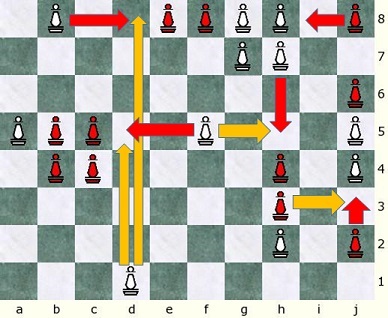
Diagram 20 - Several flank attack examples
Every red arrow represents a valid linear flank attack resulting in a capture. The yellow arrows represent moves that do not result in capture.- Valid Captures: b8-d8xe8, j8-i8xh8, f5-d5xc5, h7-h5xh4 and j2-j3xj4
- Valid moves, but without captures: d1-d5, d1-d8 and f5-h5
- Illegal move: h3-j3 (since this move doesn't result in a capture, because of rule 10, this move is actually illegal)
The object of the linear attacks in rules 13 and 14 is simple: to force the collapse of any barricaded position. These new tactics should encourage both players to fight for a win, instead of cowardly moving their free men into barricaded positions and into drawish situations.
- Definition 3 - A Testudo is a solid defensive formation that is square or rectangular in nature, which is very strong and hard to break. However, just like their Roman historical counterparts, Testudo formations were the weakest on their flanks, and likewise in Petteia XXI, a Testudo formation can be broken by a linear flank attack, as was demonstrated in the previous diagram with j8-i8xh8 and f5-d5xc5.
Testudo formations are always square/rectangular in nature, and include any number of soldiers, as long as the shape is square or rectangular.

Diagram 21 - Sample Testudo formations
- Definition 4 - A Phalanx, just like it's Greek historical counterpart, is an offensive formation, that looks similar to the defensive Testudo. Look at some sample Phalanx formations below:

Diagram 22 - Sample Phalanx attacks
- Rule 15 - A Phalanx is a linear attack whereby the Phalanx turns into a Testudo and causes the capture of a soldier in the same orthogonal line (row or flank) and the same direction, but on the other side of the Testudo.
Look at the black 5-men Phalanx formation at c7-d7-e7-e6-d6. It looks like an incomplete Testudo. The a6-soldier can play to c6 (therefore completing a Testudo) causes a directional attack that pushes and captures the white f6-soldier. Similarly, when the white i1-soldier moves to i4 to join the Phalanx, the linear attack captures the i6-soldier.
Notes
Illegal Moves
Illegal moves need to be taken back prior to the other player making his/her next move. If both players miss the fact that an illegal move was made, and it only becomes clear afterwards that an illegal move was made, the position stays as is, without returning to the previous last legal position. The game continues as if the illegal move was legal.Players are encouraged to make sure all the rules are followed and that any illegal moves are immediately taken back.
Game Notation
Given that all soldiers move the same way, long algrebraic notation is used to record the moves in Petteia XXI; because it may become confusing from where a soldier may have come from, to a particular square when recording a game; as potentially multiple soldiers can play to the same squares. Like for Pawns in Chess, Soldier moves do not need to have the initial (S) preceding the move.Therefore the notation for each move is: [from square]-[to square](x captured piece square)
Additional traditional Chess notation symbols can also be added to indicate the quality of the moves or the result of the game when annotating Latrunculi Games. (!, ?, !?, ?!, !!, ??, 1-0, 0-1, ½-½ )
Sample Complete Petteia XXI Games
- Petteia XXI
Jose Carrillo (CAN) - Erik Lerouge (SUI)
CV Game Courier, Aug 2016

1.d2-d5 e7-e4 2.c2-c4 d7-d6 3.d1-d4 f7-f4 4.g2-g5 a7-a4 5.b2-b4 b7-b5 6.a2-a4 c7-c5 7.h4-g4xf4 e4-e5xd5 8.b1-b3 h7-h5 9.c1-c3xc5 f8-f5xg5 10.c4-c7 d6-c6xc7 11.d4-c4xa4 d8-d5 12.b3-b1 a8-a4 13.b1-b3xb5 e5-e4 14.a2-a3 e4-d4xc4 15.c3-c4 d4-e4?! (Black's last move is illegal [rule 10], but both players missed it) 16.b4-b5 g7-g5 17.a4-a5 c6-c5 18.f2-f4 d5-d4 19.f1-f3 b8-b4xc4 20.a5-b5xb4 c8-a8 21.a3-a7 e8-e6 22.a1-a6xa8 d4-a4 23.b3-a3 a4-a5xb5 24.a3-a4xa5 e6-b6 25.a4-d4xe4 g8-g6 26.e2-e6 h8-f8 27.g1-g3xg5 f8-f6 28.e6-c6xb6 h5-g5 29.d4-c4xc5 g6-g7 30.h1-h6 g7-h7 31.h6-g6xg5 h7-h6xg6 32.c6-e6 h6-g6 33.a7-g7 1-0 (stalemate, all black pawns are locked [rule 10] in separate skirmishes and unable to move)
- Petteia XXI
Jose Carrillo (CAN) - Joe Joyce (USA)
CV Game Courier, Sep 2016

1.d2-d5 g7-g4 2.g2-g3 f7-f5 3.h2-h5 e7-e3 4.f2-f3 h7-h6 5.h5-g5xg4 e8-e5 6.d5-d3xe3 h6-h5xg5
- Petteia XXI
Gary Gifford (USA) - Jose Carrillo (CAN)
CV Game Courier, Dec 2016
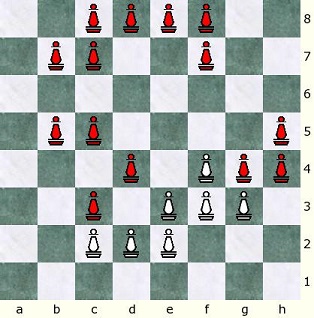
1.e2-e3?! c7-c5 2.b2-b3?! b7-b5 3.h2-h3?! h7-h4 4.f2-f4 g7-g4 5.e3-e4 a7-a4 6.d2-d4? a4-c4xd4 7.d1-d4 b5-b4 8.a2-a7?! b8-b5xb3 9.a1-a6xa8 d7-b7 10.a6-b6 b4-b3!? 11.c1-d1 b3-b4xb6 12.b1-b3 e7-c7xa7 13.g2-g3 g8-g5 14.d1-d2 g8-g5xg3 15.g1-g2 b5-b6 16.e1-e3 b6-b5xb3 17.b2-b3 h5-h6 18.f1-f3 b4-a4 19.h1-g1 h6-h5xh3 20.d2-f2! a4-b4xd4 21.g1-g2xg4 c4-c3 22.f2-d2 g5-g4 23.g2-e2 b4-d4xe4 0-1
- Petteia XXI
Jan Kutac (CZE) - Jose Carrillo (CAN)
CV Game Courier, Sep 2017
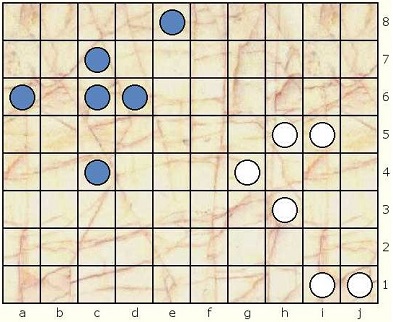
1.e2-e4 g7-g5 2.d2-d4 h7-h5 3.e1-e3 h8-h6 4.a2-a5 i7-i5 5.j2-j5?! g5-c5? [5... h5-h4!] 6.b2-b5! e7-e5 7.f2-f4 h5-h4? 8.g2-g5! h4-h5 9.f4-f5! j7-j6 10.f1-f4 h6-i6 11.d4-d5xc5xe5 i8-i7 12.g1-g4! j8-j7xj5 13.d5-e5xh5 j6-j5 14.i2-i4? i6-j6! 15.f5-f6?! i7-i6xi4 16.g5-g6 i5-f5xf6 17.g4-g5xf5 c7-c6 18.f4-f6!? c8-c7 19.a1-a4 g8-h8 20.e5-e6 h8-h6 21.d1-d6 c6-a6 22.b6-b5 c7-c6xb5 23.b1-b6xc6 b7-c7 24.d6-c6xa6 d7-d5! 25.c2-c5 d5-f5xf6 26.e4-e5xf5 f7-f6xg6 27.c5-b5 d8-d6xe6 28.c1-c5xc7 f6-e6 29.a5-a6 j7-d7 30.a4-a5xa7 e8-e7xe5 31.b6-b7 a8-a7 32.b5-b6xb8 d7-c7xb7 33.b6-b5 d6-d8 34.b5-b8 d8-c8 35.b8-a8xa7 c8-b8 36.a6-b6 c7-a7xa8 37.h2-h5 a7-a6 38.c6-d6 f8-f4! 39.g5-g4 f4-a4xa5 40.g4-b4 b8-g8 41.h1-h4 i6-i5 42.c5-g5 e7-c7 43.d6-c6xa6 e6-e5! 44.g5-g4 e5-c5xc6! 45.e3-e5 c5-c4xb4?? [... g8-g5xh5!!] 46.e5-g5xi5 a4-a6! 47.h4-h3?! h6-c6xb6 48.h5-i5 j6-d6 49.g5-h5xj5 g8-e8 ½-½ (draw agreed)
- Petteia XXI
Jan Kutac (CZE) - Erik Lerouge (SUI)
CV Game Courier, Nov 2017
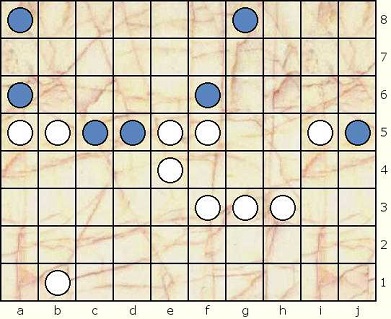
1.f2-f4 e7-e5?! 2.e2-e4! h7-h5 3.f1-f3 b7-b5 4.e1-e3xe5 c7-c5 5.j2-j5 j7-j6 6.i2-i5 g7-g5?! 7.g2-g4! h8-h6 8.g1-g3xg5 c5-g5!? 9.d2-d5! g8-g6xg4 10.d5-f5xg5 g6-g5 11.e3-e2 h6-i6! 12.g3-g4 j8-j7xj5 13.d1-g1 b5-e5xf5 14.g1-g3xg5 j6-j5xi5 15.h2-h4! i6-i5 16.h1-h3xh5 d7-d5 17.a2-a5 d8-d6 18.e2-e3xe5 f7-e7 19.f4-f5 c8-c5 20.c2-i2 e7-e5 21.a5-b5xc5 i5-g5xf5 22.g3-g2 e8-e6xe4 23.a1-a5 d5-c5 24.g2-g3xg5 d6-c6 25.e3-d3 e5-d5 26.b2-b4 f8-f5 27.f3-f4 d5-d4 28.i2-f2 e6-d6 29.f2-f3xf5 j5-d5xb5 30.f4-e4 a7-a6 31.c1-c4xd4 c6-c7 32.b4-b5 c7-c6xc4 33.f3-f5 i7-f7 34.f5-e5xd5 d6-d5 35.g4-g5 f7-f5xe5 36.e4-e5xf5 c6-b6 37.h4-a4 b6-f6 38.g5-f5 b8-g8 39.j1-j5 i8-i4 40.d3-f3 j7-j6 41.a4-e4 i4-f4xf5 42.j5-f5xf4 j6-j5 43.i1-i5 1-0
Game Courier Presets - Petteia XXI

Magnetic Chess Pieces: on 8x8, 10x8 or 12x8 boards
Draughts Pieces: on 8x8, 10x8 or 12x8 boards
Unchequered board with Go stones: on 8x8, 10x8 or 12x8 boards
Single Stone Latrunculi XXI
This game is basically Petteia with one row of soldiers (instead of two); but it's also the same as Latrunculi XXI without any Duxes.It is meant to be a training tool to the basics of soldier movement in Latrunculi XXI, without the added tactical complexity of having a second row of soldiers as in Petteia.

The objective of the game (just like in Petteia XXI) is to annihilate the opponent's army, or to win by stalemating the opponent.
Game Courier Presets - Single Stone Latrunculi XXI
Magnetic Chess Pieces: on 8x8, 10x8 or 12x8 boardsDraughts Pieces: on 8x8, 10x8 or 12x8 boards
Unchequered board with Go stones: on 8x8, 10x8 or 12x8 boards
Game Courier Logs
Game Courier Logs for Games of Petteia XXIGame Courier Logs for every Game of the Latrunculi/Petteia XXI complex
To see actual games that have been played on-line, follow the link above.
Latrunculi XXI and Petteia XXI were created by Jose Manuel Carrillo-Muniz, from Puerto Rico in 2015.
Chess Variants by the Author:
- Modern Chess Complex
- Modern Random Chess (9x9)
- Contemporary Random Chess (8x8)
- Prime Ministers Chess (9x8)
- Pseudo-Modern Random Chess (9x9)
- Chess8400 (9x9)
- Prime Ministers Contemporary Random Chess (8x8)
- Prime Ministers Random Chess (9x8)
- Hia Chess (9x8)
- Modern Capablanca Random Chess (10x8)
- English Chess Complex
- Modern English Random Chess (10x10)
- International Contemporary Random Chess (10x10)
- International Fischer Random Chess (10x10)
- Courier Chess Complex
- Courier Chess Moderno (12x8)
- Mini Courier Chess Moderno (10x8)
- Silver Elephant Chess (10x8)
- Modern Ministers Courier Chess (11x8)
- Ajax Complex
- Ajax Chess (10x10)
- Ajax Orthodox Chess (8x8)
- Ajax Random Chess (8x8)
- Ajax Modern Random Chess (9x9)
- Ajax Ministers Chess (10x8)
- Ajax Falcon Chess (10x8)
- Ajax-Capablanca Chess (10x8)
- Ajax 3D Chess (8x8x3)
- Korean Random Chess (9x10)
- Latrunculi XXI (10x8)
- Petteia XXI (8x8)
- Partnership Chaturanga (8x8)
Other Presets by the Author:
- Chaturanga - Davidson Variation on an original Indian ashtapada board (or on an uncheckered plain board)
- Modern Chess Preset
- Fischer Random Chess Preset
- Makruk (Thai Chess) Preset
- Modern Shatranj Preset
- Ajax Xiangqi (9x10) proposed by Charles Gilman
- Ajax Bigamous Chess (9x8) by Carlos Cetina
- Ajax Euchess (10x10) by Carlos Cetina
- Frolov Chess - Ajax Variation (9x9)
- Hiashatar (Mongolian Decimal Chess) (10x10)
- Milenium 3D Chess (8x8x3) by William L. D'Agostino
Other Pages by the Author:
- How to Generate Random Positions
- The Bishop Adjustment Rule
- The Modern Principles
- Reverse Symmetry
- The Prime Minister
- The Courier Elephant
- The 10x8 Variants
- Checkers Variants
 This 'user submitted' page is a collaboration between the posting user and the Chess Variant Pages. Registered contributors to the Chess Variant Pages have the ability to post their own works, subject to review and editing by the Chess Variant Pages Editorial Staff.
This 'user submitted' page is a collaboration between the posting user and the Chess Variant Pages. Registered contributors to the Chess Variant Pages have the ability to post their own works, subject to review and editing by the Chess Variant Pages Editorial Staff.
By Jose Carrillo.
Web page created: 2016-08-28. Web page last updated: 2016-12-24
